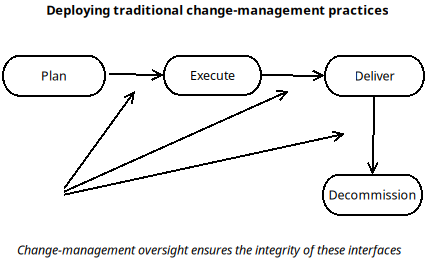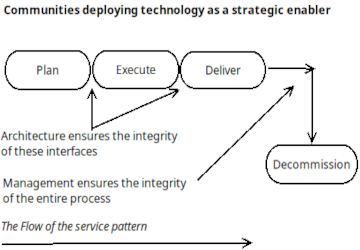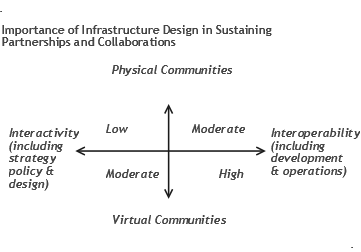
Viable partnerships and collaborations will need a new combination of governance, change management methodologies, operational platforms and tools.
When communities combine operational platforms that previously required occasional adjustment into a new composite presence, the resulting infrastructure will experience a higher frequency and complexity of change. Community platforms require a new approach to change oversight and management if they are to stay current and protect the viability and integrity of the community as it evolves and reshapes itself over time.
Communities are typically formed to address challenges beyond the capacity of each of their prospective members. The expectation is that the merged entity will better enable new regulatory frameworks, designs, developments and operational approaches by utilizing process and service linkages across sector and organizational boundaries. Working together in this way communities can create higher-order products and services, improve client focus and increases the prospect of operational efficiency.
However, when communities are first formed they typically focus on demonstrating their relative advantage through quick wins achieved used methodologies and tools inherited from dominant vertically integrated players. While utilizing such inherited approaches might provide early validation of a community approach, it will likely impede longer-term minority member engagement in the innovation needed for community survival. What enduring communities need more than early wins is broadly-based engagement in the foundational development of community frameworks and architectures that define next-generation approaches to opportunities through innovation.
Management oversight of this totality must be an effective coordinator of disparate actors and roles. It must map the optimal coordination of platforms, methodologies and tools in order to discharge its responsibilities for the product and/or service life cycle. The diagram to the right describes the traditional change management role in the plan, execute, deliver and decommission life cycle.

The command and control orientation of unified management may be what enables separate functions to work effectively together for the benefit of the organizational whole. But, beyond relatively small or well focused peer community implementations, partnerships and collaborations that grow to be megacommunities cannot be managed in this way.
Community members simply do not respond well to command and control; they may be driven by commitment to a common goal, but do not necessarily exhibit a common culture or behaviour. They need community-endorsed platforms to enable their dialogue, but also need their own capacity to manage the content they have committed to. This separation of community platform governance from member content management is more abstract than the traditional management of functions, but it better protects a community's innovative capacity, integrity and privacy.
To achieve this separation, communities need to deploy technology as a strategic enabler. For technology to be effective in this way, the entire product or service life cycle needs to be architected, as shown to the left, at least as a collective, but preferably as a unified process. This means that expert practitioners in different parts of an organization or community will no longer be free to select and deploy their own approaches to governance and platforms, methodologies and tools: they will all need to recognize and work within the larger system and deploy components that are compatible with it, and operate as part of a new interdependent whole.


But the shift from vertical to horizontal also introduces other challenges. As the number of participants increase, the stability of community infrastructures tends to decrease. The shortening of the stable state of infrastructures eventually leads to traditional change management processes becoming inoperable.
When the time taken to effect change is longer than the stable state of the infrastructure, change management costs rise and alternative means of maintaining the viability of communities and their services must be found. When this state of affairs is experienced, change is no longer part of the macro-agenda. It becomes part of a micro-agenda needing to be addressed on an ongoing and continuous basis. The life cycle speeds up: planning, provisioning and service delivery need direct interfaces: and planners, designers and providers need to become an integral part of that continuum. The real agenda will move from the separate management of design and operations to the integral management of the entire life cycle.
Process and service innovation will become critical, especially in megacommunities. The separate and incremental deployment model will need to be replaced by one where the planner, designer and provider roles connect with continuous integrity.
Methodologies, processes and tools that may have been optional in the management of traditional organizations, will become necessary for the effective governance of communities, especially in the 'highly important' situations described in the diagram on the right.